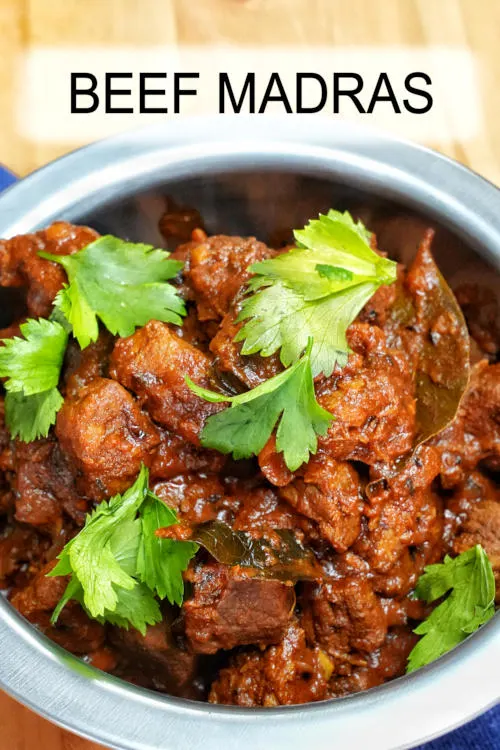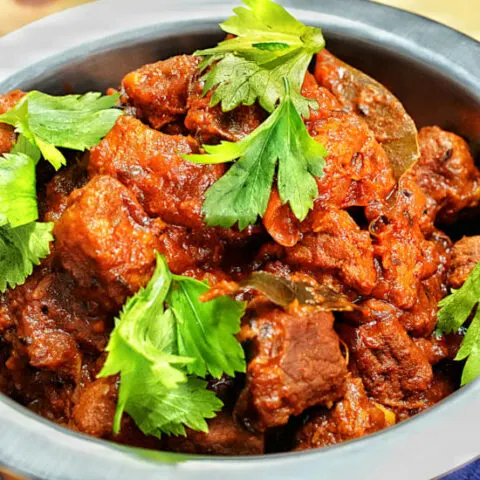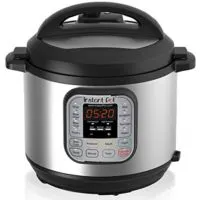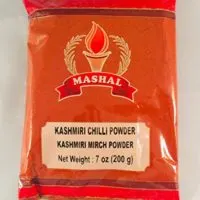Beef Madras is a curry dish made with tender beef and aromatic spices. It is a rich, fragrant, and relatively hot curry that can be served with flavored rice, naan, and cooling raita (yogurt salad) for a complete meal. The key features of a Madras curry are hot and spicy, with vibrant deep reddy brown color achieved from Kashmiri chili powder (or paprika for a milder flavor). The spices required include coriander, cumin, turmeric, garam masala, and chili powder. Store-bought Madras curry powder is available for convenience.
The origin of Madras curry is complicated. Although Madras (now Chennai) is the name of a city in India, it is likely an English invention. When the British colonized India, they found the food too spicy and unfamiliar. As a result, they modified the authentic recipe to suit their taste and called it Madras curry.
Note: This post may contain affiliate links. Please read my privacy policy for more info. I may receive commissions for purchases made through links in this post. As an Amazon Associate, I earn from qualifying purchases.

1. A quick and easy Beef Madras recipe
In this beef Madras curry recipe, I’ll show you a quick and easy way to cook beef Madras that still delivers fantastic flavors. Rest assured that the flavor will be the same as those you enjoy at your favorite restaurant.
To ensure both simplicity and quality, I follow a few key steps:
- Instead of grounding the whole spices, I use readily available ground spices commonly found in any kitchen where Indian cuisine is regularly cooked.
- To save time, I substitute fresh tomatoes with tomato paste.
- There’s an optional step to sear the beef before stewing it. You can decide whether to include this step based on your available time. I prefer to sear the beef, but skip it if I’m pressed for time.
- I used minced garlic and ginger since they are available in my refrigerator. However, you can opt for store-bought ginger garlic paste for convenience.
- I prefer using a slow cooker for this recipe, as it is mostly hands-off, passive cooking.
- Lastly, while curry leaf is something I enjoy, it’s an optional ingredient you can choose to include or leave out according to your taste preferences.
2. Preparing for cooking Beef Madras
Before diving into the cooking process, completing the necessary preparation steps for beef Madras is essential. Here’s what you need to do:
- Beef: Begin by cutting the beef into one-inch cubes. I typically use topside, but rump, chuck, or brisket are equally suitable options for making beef Madras. The choice between fattier or leaner beef is entirely up to you, depending on your preference.
- Onion: Dice the onion into small pieces. The smaller dice will break down more quickly during stewing, creating a thick and luscious gravy.
- Tomato: To save time, I prefer tomato paste (sometimes I use tomato puree). However, if you prefer, you can chop some fresh tomatoes as a simple alternative.
- Ginger and Garlic: The quickest method is to use store-bought ginger-garlic paste. Alternatively, peel ginger and garlic in your free time, then blend them into a paste using a spice grinder. This homemade ginger garlic paste can be refrigerated for up to two weeks.
- The spice mixture: For the majority of the spices, I rely on store-bought ground versions to prepare beef Madras. I diligently check the spices’ expiration dates to ensure the best flavor. Additionally, I opt for smaller packaging sizes to avoid keeping ground spices in my pantry for an extended period. The spaces I use are bay leaf, ground turmeric, ground coriander, garam masala, ground cumin, and Kashmiri chili powder. You can also include some fresh chili for an extra kick of spiciness
- Curry Leaves: While curry leaves are commonly used in Southern Indian cuisine, they may not be readily available in certain places, especially in some Western countries. If fresh curry leaves aren’t accessible, use dried curry leaves. However, omitting them is okay if both are unavailable.

3. Browning the beef: Optional, but worth It
As mentioned earlier, browning the beef is optional, but it’s highly recommended if you have the time. By browning the beef before slow cooking it, you’ll unlock a depth of flavor that can’t be achieved through stewing alone. It adds an extra layer of deliciousness to your dish.
However, since beef Madras is packed with intense flavors from its spice combination, the decision to brown the beef ultimately depends on your available cooking time. Even without browning, the dish will still turn out incredibly tasty.
If you brown the beef, follow these simple steps: Heat some oil over medium-high heat, then add the beef cubes. Allow them to brown on both sides. To prevent splattering and ensure a better browning effect, I recommend wiping the beef cubes with a kitchen towel to keep them dry.
While browning the beef is optional, taking the time to do so can elevate the overall flavor of your beef Madras.
4. Tempering cumin seeds and sauteing the aromatics
This step is essential, and do not skip it. Tempering involves heating the spices in oil to extract their flavors.
To begin, heat a little oil over low heat. Add the cumin seeds and cook until their aroma wafts from the pan. This is the indication they have been properly tempered. Add the curry leaves, chopped ginger, and garlic. Saute them until they become aromatic and fragrant. Finally, add the chopped onions and continue sauteing until they turn translucent.
You are ready to stew the beef after completing these crucial steps.
5. Stew the beef until soft and tender
As I mentioned, I will use my time-tested (but old) slow cooker to prepare the beef. There is some nostalgic feeling baked in it as it is an old Crockpot passed down from my parents. It still works after more than thirty years!
You can certainly use a modern multicooker, slow cook, or pressured cook the beef. The method is the same whichever way you choose. Remember that a pressure cooker requires much less liquid, so please use less water or beef stock to ensure the final result is a thick sauce. As for the slow cooker, I started with boiling water to expedite the process and opened it once to stir the beef to ensure even cooking.
If the water level is insufficient, add a splash of water as needed and monitor it periodically. Keep in mind that adding an excessive amount of water will result in the curry becoming overly diluted.
The best way to decide the exact cook time required is to do a taste test. You can then add salt or other spices if required, and you must cook further until the tenderness you want.
6. Serving Beef Madras: A Flavorful Delight
Once satisfied with the taste and tenderness, carefully remove the beef from the pot and transfer it to a serving bowl.
For a visually appealing presentation, garnish the dish with fresh coriander leaves and a touch of red chili before serving.
Also, consider adding some fresh lemon juice for a delightful burst of freshness.
The most popular accompaniment to beef Madras is steamed Basmati rice. You can choose plain rice or biryani. Besides, Indian bread, such as naan bread, is a common and delicious choice to accompany this dish.
To balance out the spiciness of this slow cooker beef Madras, consider preparing some refreshing Raita—a traditional yogurt-based side dish that offers a cooling contrast.
7. Explore More Delightful curry dishes
If you’ve enjoyed this flavorful beef curry, I would love to introduce you to other delightful curry recipes. Here are my top picks for you to explore:
- Try this simple recipe on my food blog if you want a vegetarian curry.
- Explore a milder option with Chinese-style chicken curry for a change.
- I highly recommend trying this green curry if you want Thai-inspired cuisine.

Beef Madras curry- Easy Indian recipe with slow cooker
Enjoy the authentic taste of Beef Madras curry at home with this simple Indian recipe. It is made even easier with a slow cooker.
Ingredients
Ingredients A
- 2 tbsp cooking oil
- 1 kg beef (chuck, brisket, or rump) cut into 1-inch cubes
Ingredients B
- 1 tsp cumin seeds
- Curry leaves
- 1 cup chopped onions
- 1 tbsp garlic paste
- 1 tbsp ginger paste
Ingredients C
- Bay leaves
- 1/2 tsp turmeric powder
- 1/2 tsp cumin powder
- 1 tbsp coriander powder
- 1 tbsp garam masala
- 1 tbsp Kashmiri chili powder
- 2 tbsp tomato paste
- 1/4 cup chopped coriander (cilantro) leaves
- Salt to taste
- Water or stock sufficient to stew the beef
Instructions
Preparation
- Cut the beef into one-inch cubes.
- Get prepared one cup of chopped onions, one tbsp of chopped garlic, and one tbsp of chopped ginger.
- Gather and measure all the ground spices: 1/2 tsp turmeric powder, 1/2 tsp cumin powder, 1 tbsp coriander powder, 1 tbsp garam masala, 1 tbsp Kashmiri chili powder, and some curry leaves (optional)
- Also, prepare 2 tbsp of tomato paste, chopped coriander, and curry leaves.
Tempering and sauteing
- Sear the beef cubes in hot oil until they develop some charred marks. (This is an optional step).
- Place the beef and all other ingredients we have prepared so far into a pot. There are various options you can choose from. Using a pressure cooker is the fastest way.
- Temper the cumin seeds in oil, then add the garlic, ginger, and curry leaves. When aromatic, add the chopped onion and saute until translucent.
Stewing the beef
- Transfer all the ingredients in A, B, and C to a pot. Add water to stew the beef.
- Season with salt.
- When the beef becomes tender, do a taste test to make the final adjustment.
- Dish out and garnish with coriander leaves to serve.
Recommended Products
As an Amazon Associate and member of other affiliate programs, I earn from qualifying purchases.
-
 Asian Kitchen Ginger-Garlic Cooking Paste 26.5oz (750g) ~ Vegan | Glass Jar | Gluten Free | NON-GMO | No Colors | Indian Origin
Asian Kitchen Ginger-Garlic Cooking Paste 26.5oz (750g) ~ Vegan | Glass Jar | Gluten Free | NON-GMO | No Colors | Indian Origin -
 Instant Pot DUO60 6 Qt 7-in-1 Multi-Use Programmable Pressure Cooker, Slow Cooker, Rice Cooker, Steamer, Sauté, Yogurt Maker and Warmer
Instant Pot DUO60 6 Qt 7-in-1 Multi-Use Programmable Pressure Cooker, Slow Cooker, Rice Cooker, Steamer, Sauté, Yogurt Maker and Warmer -
 Great Bazaar Swad Cumin Seeds, 7 Ounce
Great Bazaar Swad Cumin Seeds, 7 Ounce -
 Mashal Kashmiri Chili Powder 7 oz (200 gm)
Mashal Kashmiri Chili Powder 7 oz (200 gm)
Nutrition Information:
Yield: 3 Serving Size: 1Amount Per Serving: Calories: 469Total Fat: 25gSaturated Fat: 6gTrans Fat: 1gUnsaturated Fat: 18gCholesterol: 84mgSodium: 698mgCarbohydrates: 32gFiber: 6gSugar: 10gProtein: 32g
This data was provided and calculated by Nutritionix on 7/9/2023

Mylene
Tuesday 11th of July 2023
Love curry i will try and make it thanks for your recipe
KP Kwan
Tuesday 11th of July 2023
Hi, this is KP Kwan. I am happy to see you in this comment area, as you have read through my recipe. I am glad to reply to any questions and comments as soon as possible.